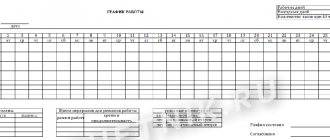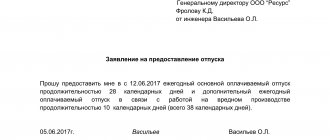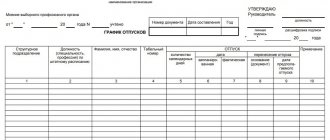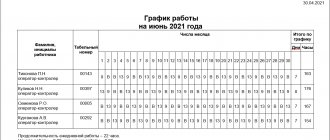guards for 3 people per shift
for 3 people: 2 people per shift
in three days
for 3 people for 12 hours
for 4 guards
two after two with a 12-hour working day
Some businesses or services, such as lifeguards, operate 24 hours a day, seven days a week. This approach is objectively necessary and socially significant. For commercial enterprises, this option of using the working time of their employees is also sometimes justified. For example, the property of an enterprise requires 24-hour security.
When does a shift work schedule apply?
A shift schedule is a fairly common phenomenon. It is used in a wide variety of industries, most often in companies with a continuous round-the-clock production cycle - the need for its use here is due to the fact that equipment downtime is unacceptable, because they lead to system failures and significant financial losses. But regular, timely replacement of personnel leads to an increase in the volume of output, improved labor productivity and, as a result, greater profits.
Also, a shift schedule is common in other areas, for example, in medical institutions, security structures, firefighters, gas services, rail and transport transportation, air travel, etc.
Why do you need a shift schedule?
The shift schedule is one of the most important internal documents of the company.
Based on the schedule, employees' working hours are recorded and their wages are subsequently calculated.
Thus, it relates not only to methods of organizing work at an enterprise, but is also a serious accounting form.
We must not forget that if the company provides for shift work, then the availability of the schedule is necessarily checked by government supervisory structures (for example, the labor inspectorate and the tax service). The absence of this document may result in the imposition of an administrative penalty on the enterprise and its management in the form of a fairly large fine.
How to determine the number of shifts
The shift lasts from 3 to 12 hours during the day. The quantity is determined by the employer depending on the characteristics of the production process. The document is used throughout the year or season - when demand increases. The number of employees per shift is not limited.
As a rule, the algorithm for how to correctly draw up a work schedule for a 12-hour working day represents a direct order of rotation of employees (the first is worked - rest - inclusion in the second, third, etc.) or reverse (the first is worked - rest - inclusion in the third , then to the second, etc.). If there is a continuous process, the enterprise uses a 4-step algorithm (3 shifts work 24 hours, the fourth is on vacation).
When determining the number of shifts and employees employed in them, the employer takes into account the permitted length of working time for special categories defined by Art. 94 of the Labor Code of the Russian Federation, and the employee’s reduced working hours.
There is no universal formula for how to create a daily schedule so that there is no overtime; it all depends on the specific working conditions. When summarizing working hours, it is recommended to take into account the following: the longest accounting period is established (the maximum according to the Labor Code of the Russian Federation is a year), when carrying out accounting, they are guided by a weekly norm of 40 hours, and within the overtime period they are compensated for shortcomings. Working hours standards in 2022:
- for a 40-hour work week - 1973 hours;
- for 36-hour - 1775.40 hours;
- for 24-hour - 1182.60 hours.
The shift schedule is drawn up so that there is no overtime during the accounting period. If a 2 by 2 labor system is introduced with a 12-hour working day (taking into account alternating shifts) and the accounting period is a month with a norm of 160 hours (40 hours per week × 4 = 160), then the monthly work hours will be:
(30 / 2 ) × 12 = 180.
Due to exceeding the norm of 160 hours, additional days off are provided, which is reflected in the shift schedule. The legislation does not clearly establish how to draw up a schedule for 3 people so that 2 are in a shift, the procedure is as follows: so that out of three workers two work in a shift, it is established that one works in the morning and the second in the evening, then shifts are introduced for the third employee in the morning , the first employee works in the evening, the second is given a day off, etc.
Legislative regulation, mandatory conditions
The shift schedule is regulated by law, namely Art. 372 of the Labor Code of the Russian Federation (Part 3 of Article 103 of the Labor Code of the Russian Federation). When introducing it into an organization, it is required to strictly comply with the norms and conditions of the above section of the Labor Code of the Russian Federation.
The rules for operating in this mode are spelled out here quite thoroughly and clearly. There is no point in listing them in this article, but some simply need to be emphasized:
- the weekly working hours in the sum of all shifts should not exceed forty hours;
- every shift people should be given a lunch break (its duration is determined individually - from 30 minutes to 2 hours);
- employees must be provided with uninterrupted rest for 42 hours every week;
- the employer is obliged to indicate to employees that it is inadmissible for them to perform their duties in two shifts in a row (except in emergency cases) - and strictly monitor this.
If an organization feels the need to use a shift schedule for different categories (positions) of employees, then for each of them the duration of the shift can be determined separately (such situations occur in transport companies - one work mode is used for drivers, another for dispatchers, and another for service personnel). third).
When creating a schedule, one more important point should be taken into account - if most of it falls at night, then the shift should automatically be reduced by an hour.
All other working conditions must also comply with the law, including in matters relating to the payment of wages, provision of sick leave, vacation, etc.
Reasons for introducing shift work
IMPORTANT! Recommendations for introducing shift work in an organization from ConsultantPlus are available here
Shift schedule is work organized in a special way, when working time is divided into two, three or four shifts, when each working group carries out its activities during one established working period of time according to an established schedule.
ATTENTION! It is prohibited for the same group of workers to work two shifts in a row.
Labor Code of the Russian Federation in Art. 103 provides for the possibility of organizing work on a shift schedule. The law specifies the features of this schedule and the circumstances that may serve as grounds for its introduction :
- the features of production require a continuous labor process;
- under normal operating conditions, the duration of the working day will exceed the permissible duration established by law;
- such a schedule will help increase the volume of products or services provided;
- thus, the efficiency of using equipment, machinery and tools increases.
IMPORTANT! The objectivity of these grounds allows the employer to introduce a shift schedule when he finds it appropriate.
What is not considered a shift schedule
Some personnel officers mistakenly believe that the work schedule is a day after two/three, two days after two, etc., refers to shift work. If you carefully read the labor legislation of the Russian Federation, it turns out that this is not so. A group of workers, performing their job duties during one day and being replaced by others the next day, works in a regime fixed within the enterprise, but there is no clear procedure for developing such a regime, its coordination and approval.
Examples of how to create a shift schedule
Let's show an example of the guards' work schedule with a 12-hour working day on weekdays and a 24-hour working day on weekends, when the organization is closed.
| September 2022 | ||||||||||||||||||||||||||||||
| FULL NAME. | 1 | 2 | 3 | 4 | 5 | 6 | 7 | 8 | 9 | 10 | 11 | 12 | 13 | 14 | 15 | 16 | 17 | 18 | 19 | 20 | 21 | 22 | 23 | 24 | 25 | 26 | 27 | 28 | 29 | 30 |
| Wed | Thu | Fri | Sat | Sun | Mon | Tue | Wed | Thu | Fri | Sat | Sun | Mon | Tue | Wed | Thu | Fri | Sat | Sun | Mon | Tue | Wed | Thu | Fri | Sat | Sun | Mon | Tue | Wed | Thu | |
| Watchman 1 | — | at | — | 24 | — | V | — | at | — | at | — | 24 | — | V | at | V | V | — | — | at | V | — | at | — | 24 | — | V | at | V | — |
| Watchman 2 | at | — | at | — | 24 | — | V | V | V | V | — | — | at | at | — | at | — | 24 | — | V | — | V | — | at | — | 24 | — | V | — | V |
| Watchman 3 | V | V | V | — | — | at | at | — | at | — | 24 | — | V | — | V | — | at | — | 24 | — | at | at | V | V | — | — | at | — | at | at |
Quite common is the schedule of a day every three to 24 hours, although here we are talking about a rotating work schedule, and not shifts. The sample is based on 4 workers.
| September 2022 | ||||||||||||||||||||||||||||||
| FULL NAME. | 1 | 2 | 3 | 4 | 5 | 6 | 7 | 8 | 9 | 10 | 11 | 12 | 13 | 14 | 15 | 16 | 17 | 18 | 19 | 20 | 21 | 22 | 23 | 24 | 25 | 26 | 27 | 28 | 29 | 30 |
| Employee 1 | 24 | — | — | — | 24 | — | — | — | 24 | — | — | — | 24 | — | — | — | 24 | — | — | — | 24 | — | — | — | 24 | — | — | — | 24 | — |
| Employee 2 | — | 24 | — | — | — | 24 | — | — | — | 24 | — | — | — | 24 | — | — | — | 24 | — | — | — | 24 | — | — | — | 24 | — | — | — | 24 |
| Worker 3 | — | — | 24 | — | — | — | 24 | — | — | — | 24 | — | — | — | 24 | — | — | — | 24 | — | — | — | 24 | — | — | — | 24 | — | — | — |
| Worker 4 | — | — | — | 24 | — | — | — | 24 | — | — | — | 24 | — | — | — | 24 | — | — | — | 24 | — | — | — | 24 | — | — | — | 24 | — | — |
Another example of how to create a schedule for 3 people, so that 2 are on shift and one employee is on rest. Please note that there are also features of the work schedule, but not shifts.
In case of production necessity, the manager has the right to calculate a 2/2 work schedule for 2022, 12 hours each. A possible option for such a work and rest schedule for employees:
When creating any monthly schedule, remember about overtime. Take them into account when planning employee holidays and calculating additional payments for overtime hours worked.
Some points regarding payment
The calculation of remuneration for a shift schedule is somewhat different from the standard one. The specificity here is that the number of working hours according to the regime established at the enterprise may differ from the norm established by law, both upward and downward (the so-called planned overtime or underwork).
To ensure that there are no errors in salary calculations, at the end of the accounting period, the following parameters should be reconciled: the number of working hours in accordance with the norm and their number, based on real indicators. If, when comparing, the second indicator is greater than the first, you will need to calculate and pay the employee extra for overtime.
If an employee’s shift falls on a day off, then it is paid as usual (this is justified by the peculiarities of the shift conditions). If he is forced to work on a holiday (state non-working days are specified in the Labor Code of the Russian Federation), then he must be paid at the appropriate standard rate, i.e. in double size.
Work on holidays
According to the shift schedule, employees may be required to work on non-working holidays. At the same time, the provision on the transfer of days off does not apply to organizations with a shift work schedule (paragraph 2, clause 2 of the Procedure approved by order of the Ministry of Health and Social Development of Russia dated August 13, 2009 No. 588n). If the weekends established by the shift schedule coincide with non-working holidays, these weekends are not transferred to the next working day after the holiday.
As a general rule, for work on a holiday within the monthly time limit (i.e. if the holiday is a working day according to the shift schedule), pay an additional payment in the amount of a single daily or hourly rate above the salary (Article 153 of the Labor Code of the Russian Federation).
Situation: how to pay a salaried employee for work on holidays on a shift schedule?
The answer to this question depends on how work was carried out on holidays:
- within normal working hours;
- beyond normal working hours.
Non-working holidays are established for all employees, without exception, by Article 112 of the Labor Code of the Russian Federation. Therefore, work on such days is subject to additional payment (Article 153 of the Labor Code of the Russian Federation).
Let’s say that an employment contract establishes a working hours regime that provides for work on non-working holidays (for example, a shift work schedule), and it was carried out within the normal working hours. In this case, pay for work on holidays at least a single daily or hourly rate in addition to the salary (i.e., at least double the amount).
If work on holidays was carried out in excess of normal working hours, then the employee’s remuneration must be no less than double the daily or hourly rate in excess of the salary (i.e., no less than triple the amount).
Specific amounts of payment for work on holidays can be established in a collective agreement or in a local regulatory document of the organization, for example, in the Regulations on Remuneration.
In addition, instead of increased pay for working on a holiday in excess of normal working hours, at the employee’s request, he can be given another day of rest, for example in the same month. In this case, it is considered that the person worked on a holiday within the normal working hours. Pay for the work for this day in the general manner: in a single amount. Do not pay extra for a day off.
This procedure is established by Article 153 of the Labor Code of the Russian Federation.
Example of salary calculation. The work shift falls on a holiday. The employee's salary is set
Locksmith A.I. Ivanov works on a 40-hour work week on a shift schedule. Under this regime, the monthly working hours in January are 120 hours.
One of the shifts falls on the holiday of January 7th. Ivanov worked eight hours on the holiday. According to the working time sheet for the month, Ivanov worked 120 hours.
His salary is 25,000 rubles. The organization's accountant calculated the additional payment for working on a holiday as follows.
Ivanov worked in January within normal working hours (120 hours). This means that work time on a holiday is paid at a single daily rate.
With a 40-hour work week, the average monthly number of working hours is 164.25 hours. Therefore, the employee’s hourly rate is: 25,000 rubles. : 164.25 days = 152.21 rub./day.
The additional payment for work on January 7 will be: 152.21 rubles/day. × 1 × 8 hours = 1217.68 rub.
Ivanov was not given any other additional payments or allowances. His salary for January will be: 25,000 rubles. + 1217.68 rub. = 26,217.68 rub.
Consolidating the work order
If the management of an enterprise decides to use a shift work schedule, it must enshrine this norm in its accounting policies, or more precisely, in its Internal Regulations.
If the company has a trade union cell, these Rules, including those regarding shift work, must be approved by its representative. A five-day period is allotted for interaction with the trade union - during this period, trade unionists must either approve the Rules presented to them or challenge them with evidence.
It is also possible to establish the use of a shift schedule in a collective agreement.
In addition to the internal regulations and the collective agreement, the clause on shift work must be spelled out in sections of individual employment contracts with employees, indicating the number of hours per shift and other parameters.
Who draws up the document and how?
The shift schedule is drawn up locally by the organization’s HR employee. The date of its entry into force is indicated in the order signed by the head. All other regulations and working hours are covered in detail in the internal regulations of the organization.
The local regulatory act in which this schedule should be described is consistent with the trade union organization in accordance with Article 372. After all, the trade union reflects the opinion of the active part of the specialists.
The project is reviewed within five working days. During this time, “activists” are required to send a reasoned written disagreement or approval. Disagreement results in consultation meetings being required. The purpose of the meetings is to come to a mutually beneficial solution.
The process of creating a shift schedule
The first practical stage in implementing a shift schedule is an order for its creation, issued on behalf of the director of the organization. It contains instructions to create a shift schedule, period, responsible person and other necessary information.
Sample order for approval of shift schedule
Next comes the actual preparation of the document. The interests of the employer and employee must be taken into account here.
The schedule is formed in advance - at least thirty days before the start of the shift.
Each employee mentioned in the document must be familiarized with it against signature. Thus, he indicates that he agrees with this mode of operation.
After development, coordination and final approval, the schedule will be binding both for the management of the enterprise and for the employees designated in it.
Shift schedule for 2022
There is nothing complicated in the procedure for developing a shift schedule. At the same time, it is extremely important to take into account the norms of labor legislation, which describe in detail issues directly related to how to correctly draw up a schedule.
To eliminate the possibility of mistakes, let’s consider the available nuances in more detail.
Compilation rules
In order to correctly formulate the schedule, it is extremely important to take into account, in accordance with Art. 103 of the Labor Code of the Russian Federation basic components, in particular:
- the accounting period used by management to balance time;
- duration of work, which provides a work schedule;
- rules and procedures for transferring employees from one shift to another;
- the procedure for the worker to act in the event of a shift's no-show.
The norms of the Labor Code of the Russian Federation do not establish a standard form of the schedule, which is why the employer reserves the right to indicate the key conditions of the document in any form.
Who installs and compiles it and how?
The task of developing the schedule is assigned to:
- for an employee of the HR department;
- or to the head of a structural unit;
- or the company secretary.
Who exactly is obliged to draw up this is fixed by the internal acts of the company.
The main condition that must be met according to Art. 103 of the Labor Code of the Russian Federation - compliance with generally accepted rules of law, the interests of the enterprise and employees in particular.
The developed shift schedule must be approved by the head of the department and the director of the enterprise.
For what period?
The schedule can be developed for any time period - in accordance with the provisions of Art. 103 Labor Code of the Russian Federation.
In most cases, it is drawn up for a period of 1 month.
Please note: each newly created document must be approved by authorized persons of the company.
Documenting
To be able to use a shift schedule, the employer will have to:
- Issue an appropriate Order regarding the introduction of shift work.
- Display the condition for introducing a shift schedule in the Labor Regulations or in the collective agreement - in strict accordance with Article 100 of the Labor Code of the Russian Federation.
- Develop a shift schedule in accordance with the requirements of Part 2 of Art. 103 Labor Code of the Russian Federation.
- In the employment agreement, indicate the introduction of a shift schedule in accordance with the rules of Part 1 of Art. 100 and part 2 of article 57 of the Labor Code of the Russian Federation.
Let's take a closer look at the available features.
You will find a sample of filling out a time sheet in our article. You can download a free sample sick leave log here.
By whom and how is it approved?
The shift schedule is approved by the company management represented by the director.
You can view the employee’s document:
- by putting his personal signature on the Order;
- by affixing a signature on the introductory sheet.
Each of the options under Article 103 of the Labor Code of the Russian Federation will be considered legal.
Approval order (sample):
Example of an order for approval of a shift schedule
Order form for approval of shift schedule
Order of introduction (sample):
There are no difficulties in drawing up the Order on the introduction of a shift schedule. It is enough to exclude errors and typos in the content.
you can here:
Order on the introduction of shift work
The familiarization sheet is compiled in the form of a table, which indicates:
- employee initials;
- signature - confirms familiarization;
- date and other important data.
You can view the sample here:
Form, pattern and examples
As noted earlier, labor legislation does not establish the form of the schedule, which is why it can be developed in any form, but taking into account generally accepted rules.
Depending on the specific situation, there are specific features.
Sample shift schedule (form)
No processing
In this case, it is extremely important to ensure that in the case of a summarized accounting of the working period, there are no violations in the schedule under consideration, and it fully satisfies the requirements of Art. 103 Labor Code of the Russian Federation.
For example, if a company uses a shift schedule of 2 every 2, then when working 12 hours a day, an employee must work in a month: 30/2 x 12 = 180 hours.
It follows from this that in this case there is 20 hours of overtime, so temporary days off need to be introduced.
In three days
Often a shift schedule involves working throughout the day.
In this case, the sample will differ slightly from the standard one.
Shift schedule every three days
It should be remembered that to calculate the graph in question you need:
- Establish summarized recording of working hours.
- Display activity during night and day periods.
- Take into account not only the provisions of Art. 103 of the Labor Code of the Russian Federation but others, which indicate the features of breaks for rest and lunch.
Please note: making the schedule known to employees is the responsibility of every employer.
With cumulative accounting
In the case of summarized accounting, it is extremely important to pay attention to some important features.
Example form:
For a month
you can here:
Monthly work schedule
It should be noted that the provided form is unified and is suitable both for formation for several weeks and for any other period.
How to familiarize an employee?
Familiarization with the shift schedule of employees is carried out by affixing their personal signatures on the introductory sheet or in the Order.
According to the norms of Art. 103 of the Labor Code of the Russian Federation, several options can be used simultaneously.
Deadlines
Shift schedules are brought to the attention of employees no later than 30 calendar days before they come into force.
This is described in detail in Part 4 of Article 103 of the Labor Code of Russia.
Change order
In accordance with the rules of Art. 103 of the Labor Code of the Russian Federation, adjustments can be made on the initiative of:
- hired staff;
- employer.
The last option is considered the most common.
At the initiative of the employer
Employers have the legal right to change the terms of an employment agreement. The exception is operations that are directly related to assigned responsibilities.
From this it follows that it is possible to make amendments to the working day. The basis for this is Article 74 of the Labor Code of the Russian Federation.
Change order (sample):
Is it possible to change the information in it?
Changes are allowed to the approved shift schedule, but only as a last resort and in compliance with certain rules.
Firstly, if changes occur at the initiative of the employer, he must notify his subordinates in advance about them and obtain their written consent - without them, making changes legally will be problematic.
If one of the employees asks to change the shift schedule, he must draw up a special application addressed to the manager. The application must indicate the reasons for the request (it must be respectful with appropriate written justifications), then the consent of the other employees to whom the document concerns must be obtained. If colleagues and management managed to reach a compromise, a new order is formed, on the basis of which the necessary adjustments are made to the schedule.
How to coordinate with employees
The shift schedule must be agreed upon with employees in advance, as mentioned above - no later than thirty days before the start of the first shift.
Signatures of consent can be placed directly on the schedule itself, or you can make a separate sheet for this.
If the second option is chosen, then you need to make a table on the approval sheet, enter all the employees there and collect their autographs (with the date they were signed). This document will be an official attachment to the shift schedule.
Duration of work upon approval
At least two groups of personnel must work per day, that is, two shifts. The maximum working period is 12 hours a day .
In the shift schedule, at the request of the employer, a two-shift mode, a “four-team” mode and a “schedule 72” are established:
- With a two-shift work order, work is carried out in two shifts: night and day, 12 hours each.
- “Four brigades” is the optimal scheme for workers. They are divided into 4 teams. Each of them works according to the following scheme: first shift at night (4 days) - two days off - second shift during the day (4 days) - one day off - third shift in the evening (4 days) - one day off.
- With “schedule 72” one cycle is 12 days. In practice, this looks like working two days on the day shift, two days off, two days on the evening shift, one day off, two days on the night shift, three days off.
Rules for filling out the general work log can be found in this article. If you are interested in why you need a demand invoice on Form M-11, check out this material.
Features of the formation of a shift schedule, general information
If you are tasked with creating a shift schedule, and you have no idea how exactly it is formed, read our recommendations - they will give you an accurate idea of this document. Also check out the example of filling it out - based on it you can easily create your own form.
Before moving on to a detailed description of the schedule, we provide general information about the document. Let's start with the fact that there is no unified form of the schedule. This means that it can be written in free form or according to the model approved in the accounting policy of the organization. In this case, the method of forming the form must be reflected in the company’s regulations.
Regardless of which scheduling method is chosen, the document must contain a number of mandatory data:
- Company details;
- information about the place and time of compilation;
- the schedule itself.
The form must be certified by several persons. Firstly, by those employees in respect of whom it was formed, secondly, by the head of a structural unit and, thirdly, by the director of the company.
It is not necessary to certify the form with a seal - this should be done only when such a condition is in the company’s local documentation.
The schedule can be drawn up on a simple blank sheet of paper (preferably A4 format) or on the organization’s letterhead (if such a requirement is established by management). You can write it manually or on a computer (with mandatory subsequent printing).
How to take into account the shift schedule
All schedules developed at the enterprise are subject to mandatory registration in the appropriate accounting journal. After carrying out all the necessary procedures with them (development, coordination, approval, familiarization), they are transferred for storage to the company’s HR department. Here they are filed in a separate folder with other similar documents. Access to the place of their detention for unauthorized people should be limited.
The duration of their storage is indicated either in local acts of the organization, or is established by the legislation of the Russian Federation (but not less than five years). After this period has expired, the schedules can be disposed of in accordance with the procedure established by law.








